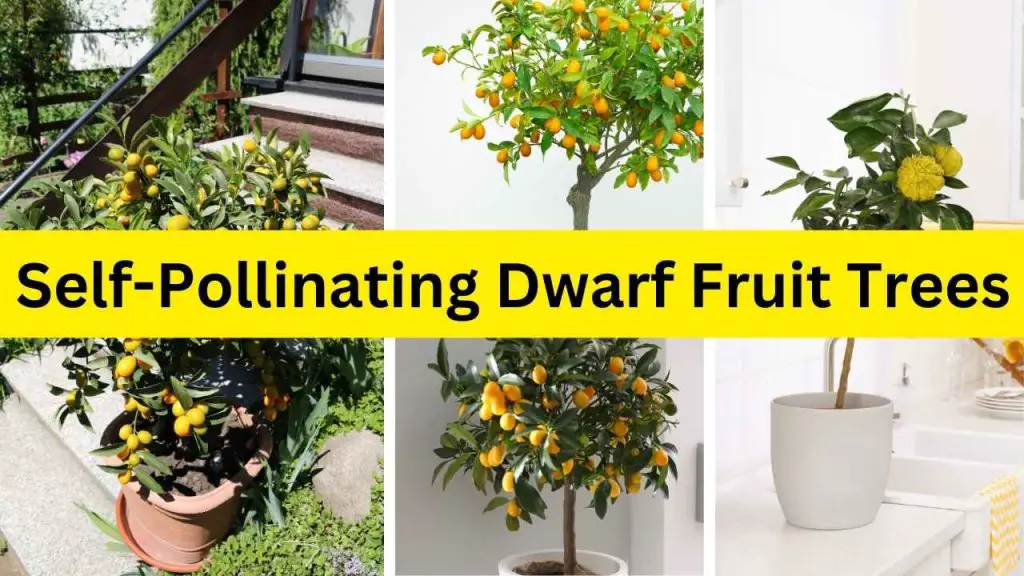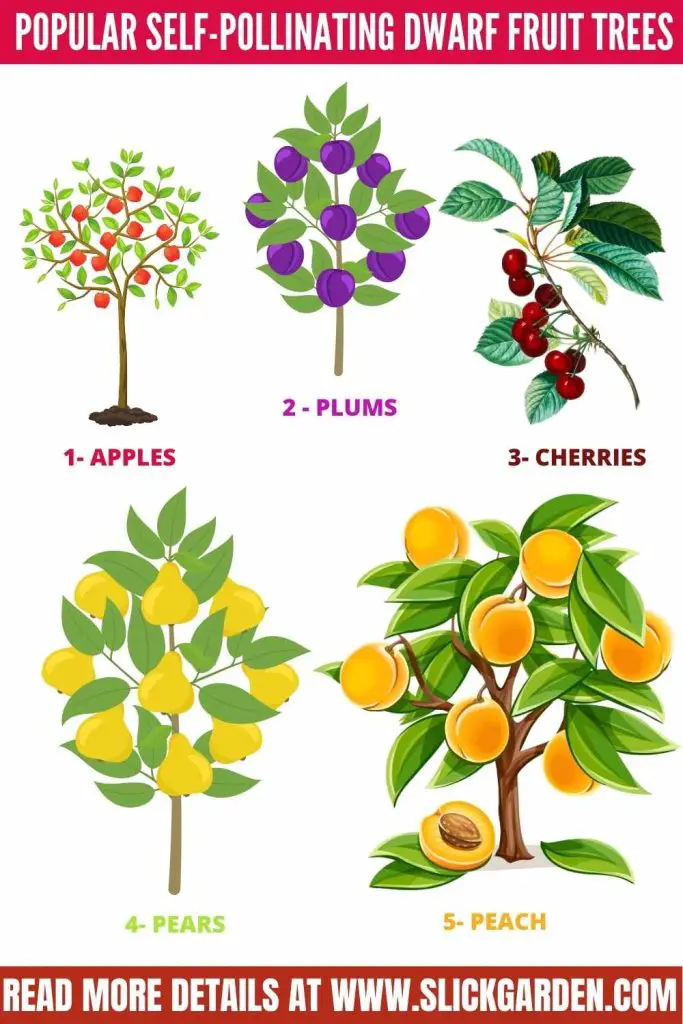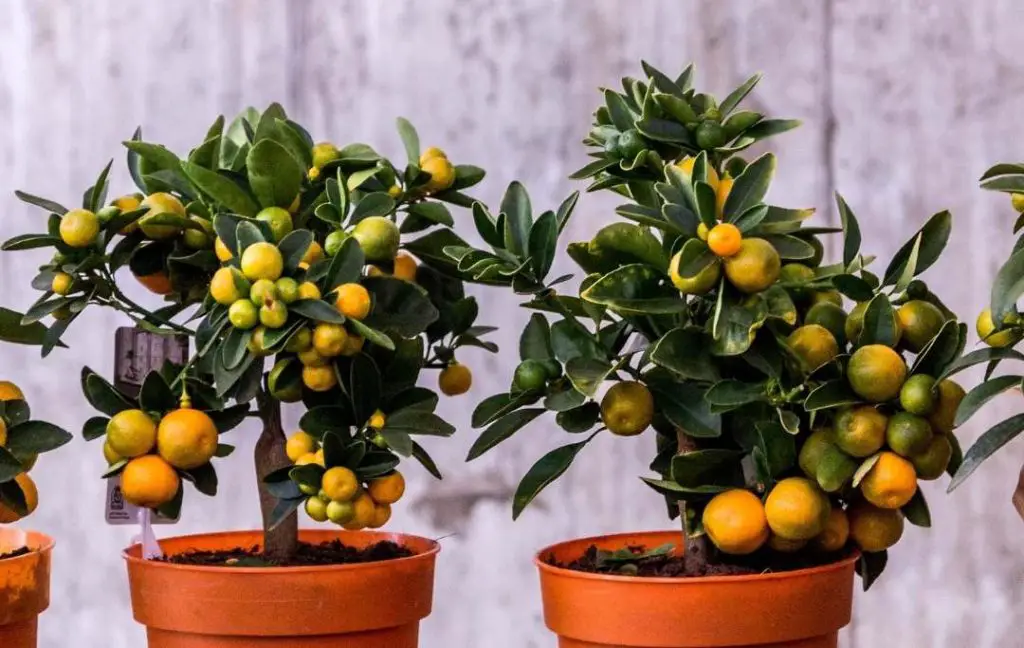If you have a small space and you are interested in growing fruit trees then you are reading the right article. Limited space is not a hindrance in growing fruit trees.

You can choose small or dwarf fruit trees according to your hardiness zone. The maximum height of a dwarf fruit tree can be 8 to 10 ft. The fruit produced by these trees is small but they need little maintenance and the fruit matures earlier in the growing season.
You can also grow these dwarf varieties of fruit in containers or larger pots. These trees will create a perfect small fruit orchard for you.
What Is Self-Pollination?
Self-pollination is a process in which pollen is transferred to the stigma of the same flower. This process occurs within a single flower or between flowers of the same dwarf fruit tree.
In self-pollination, the stamens of the male part produce pollen that has reproductive cells. The ovary and the stigma are present in the carpal of the female part of the flower in the ovary; the pollen fertilizes the ovules and finally forms seeds.
For small spaces, it is better to choose a dwarf self-pollinated fruit tree because of the absence of pollinators or other plants of the same species.
Popular Self-Pollinating Dwarf Fruit Trees
All fruit trees are not self-pollinating. Most of the plants rely on cross-pollination, in this process, the pollen from one fruit tree is transferred to the stigma of another fruit tree of the same species.
Cross-pollination is done by birds and insects, wind, and water. Self-pollinating varieties are best as they don’t need cross-pollination to produce fruit.
They don’t need the help of another tree to pollinate themselves. The question comes to your mind: how can you determine that a tree requires a pollinator?
The self-pollinating trees produce search flowers that have both male and female reproductive parts. It means they can easily fertilize themselves.
If you have a small garden or yard then you must choose dwarf self-pollinating varieties of fruiting trees. The following are the trees that are self-pollinators and need small space and you can create mini orchards.

1- APPLES
Dwarf apple trees are the best choice for small places like containers or the backyard. The maximum height of this tree can be 8 to 10 ft and it produces abundant fruit. Urban gardeners usually prefer dwarf apple trees because they need less room to grow.
This small apple dwarf tree has a manageable size. The best varieties of Apple draw trees are Cameron Select, Anna, Dorsette Golden, Granny Smith, and more. I chose to grow ‘Cameron Select’ because it is resistant to fire blight.
The fruit trees start producing after several years. Water the apple tree on time and never leave the soil dry. You should avoid overwatering to prevent your young apple tree from root rot.
For the production of healthy fruit, your plants need nutrients such as nitrogen, phosphorus, and potassium. You can use a balanced slow-release granular fertilizer to encourage new growth.
If you want to maintain a healthy dwarf apple tree then you should prune the tree when needed. For a successful harvest, you should maintain only one or two fruits on a branch.
Inspect regularly, if you find any sign of diseases then you must take action. The changing colour of the fruit is a clear sign that they are ripe. For instance, when red apples turn from pale pink to a bright red colour then you can pick them.
These apples can easily separate from the branches. The size of the fruit from a dwarf apple tree is very manageable so you can easily harvest it. The best time for harvesting is between July and November.
2 – PLUMS
When you decide to grow a home orchard in a small place then you have to choose the right dwarf variety of your favourite fruits. The best self-pollinating dwarf plum varieties are Santa Rosa, Stanley, Methley, and Burbank.
For my garden, I chose Santa Rosa. The flesh of the fruit is yellow, and the colour of the skin is purple-red with great taste.
Plum trees produce blooms in late winter or early spring. This fruit tree can easily adjust in all types of soils but you have to maintain a frequency of water because excessive moisture is not good for your fruit trees.
Plum dwarf trees like to grow in full sun so you must choose a sunny location for them. For feeding you can use a balanced 10-10-10 formula in early spring. According to the age of the tree, you can decide the quantity of the fertilizer.
Regularly examine your fruit tree, if you see any sign of pests then you have to do something to control them. You can use organic or chemical insecticides.
When you see your plum fruit is very soft and you can easily squeeze it then it means your fruit is ripe and you can pick them. If you care about the watering, fertilizing, and pruning then your dwarf plum tree will produce high-quality fruit for you.
3- CHERRIES
You must choose the right self-pollinating dwarf cherry tree varieties according to your climate. The best self-pollinating cherry varieties are Stella, North Star, and Compact Stella.
As you know your fruit tree will produce healthy fruits when you grow them in a sunny location for the production of fruit sunlight is very important.
Water your dwarf cherry tree deeply and keep it moist, especially on hot days. You should avoid overwatering because it can cause root rot and many fungal diseases.
To maintain the moisture level of the soil you can apply mulch around the base of the cherry dwarf tree. Mulching also helps to suppress weed growth.
To keep your soil rich you can use a balanced fertilizer so your fruit tree gets nutrients and produces flavorful fruits. Pruning will have to keep the size of the tree according to the space you have. Remove the diseased part of the tree to encourage new growth.
4- PEARS
If you want to grow a dwarf fruit tree that produces juicy and versatile fruit then you must select pears for your small garden. The best time to plant a pear tree is in fall or late winter.
The best variety of dwarf pear trees is Bartlett. It is our self-pollinating variety and produces fresh and juicy pears for you.
As you know dwarf pear trees are perfect for growing in small spaces but these trees sometimes need staking to grow. This will help to keep them upright. Soil is the growing medium so you should not compromise on it.
Pear dwarf trees need a sandy and loamy soil. To make your soil more rich you can add different organic materials in it. If you are growing the dwarf pear tree in the ground then make sure the pH of the soil must not be more than 8.7.
To keep your dwarf pear tree more healthy, you should prune it annually. Fire Blight disease is a common problem of dwarf pear trees. This disease is caused by a bacterium.
It is not easy to control this disease so you should never use infected tools to avoid spreading this disease accidentally.
5- PEACH
Not all peach trees are self-pollinating. The best self-fertile peach dwarf varieties are Bonanza and Tropical Beauty. Those gardeners who can’t grow multiple trees for cross-pollination must choose self-pollinating dwarf peach trees.
You can easily maintain them because they are small in size. The most important thing about self-pollinating fruit trees is that they produce fruit consistently year after year.
The size of the dwarf peach tree is half of a standard peach tree. The best time of planting a young tree is in late winter or early spring during the dormancy period. This way your young fruit tree will get enough time to establish itself in the new environment.
Peach dwarf tree needs well-drained and rich soil. Make sure the pH of the soil must be between 6.0 to 6.5. If you are growing a tree in the garden then you should have a soil test before planting the young tree.
As you know fruiting plants need 6 to 8 hours of Sunlight. So your location must be sunny. If you choose a shady area for this tree then it will lose its vigor and become susceptible to many diseases and pests.
Keep Reading:
- How To Grow Grapefruit Trees In Pots?
- 20 Fruit Trees To Grow From Cuttings
- How To Grow Fruit Trees From Seeds?
- 20 Dwarf Fruit Trees You Can Grow Indoors
Dwarf Fruit Tree Care

As you know fruit trees need full attention and care. In the case of dwarf trees, they need little maintenance and your work becomes easier. The following factors are very important when you are growing dwarf fruit trees.
LIGHT
Sunlight plays a significant role in the production of fruits. If you want a higher yield then you must select a sunny spot for your dwarf fruit trees. Tall trees and buildings can obstruct the light so make sure the location does not receive their shade.
Fruiting trees need 8 to 6 hours of sunlight for producing fruit. Apple, pear, cherry, and peach trees produce flowers in spring. Low light will not help them in blooming on time and they will produce fruit according to your desire.
SOIL
Fruit trees love to grow in well-drained and acidic soil. Loamy or sandy loam soils are also great options. You can make your soil more rich by adding a layer of compost or other beneficial organic matter.
You can use different amendments for making your soil perfect for growing self-fertile dwarf trees through trees. To control the unwanted plants and weeds and retain the moisture level in the soil you can apply 2 to 4 inches of mulch on the top of the soil.
WATER
Besides soil and sunlight, the third important factor for the growth of dwarf fruit trees is water. Overwatering and underwatering both are not good for your plants so you have to maintain the frequency of water.
Never let the soil dry completely, you can check the moisture of the soil by using your finger. On summer days pollinating dwarf fruit trees need more water than in winter.
TEMPERATURE AND HUMIDITY
Every fruit tree needs a favourable temperature and humidity for producing fruit. Before choosing any dwarf variety of fruit you should do some research or ask your local nursery or gardening store about the needs of your selected fruit tree.
FERTILIZER
Your dwarf fruit trees need continuous feeding to produce a higher yield of fruit for you. Always sprinkle the fertilizer about a foot away from the trunk of the fruit tree. You will get all the information and tips in the packet of fertilizer bags.
